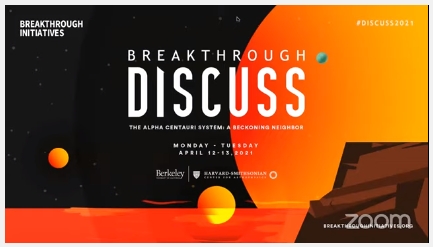Centauri Dreams
Imagining and Planning Interstellar Exploration
Biosignatures: The Oxygen Question
Just how useful is oxygen as a biosignature? It’s a question we’ve examined before, always with the cautionary note that there are non-biological mechanisms for producing oxygen which could make any detected biosignature ambiguous. But let’s go deeper into this, thanks to a new paper on ‘oxygen false positives’ out of the University of California at Santa Cruz. The paper, produced by lead author Joshua Krissansen-Totton and team, offers scenarios that can place an oxygen detection in the broader context that would distinguish any such find as biological.
Let’s begin with the fact that in addition to its obvious interest because of Earth’s history, photosynthesis involving oxygen requires the likely ubiquitous carbon dioxide and water we would expect on habitable zone planets. Helpfully, oxygen should be readily detectable on exoplanets because of its absorption features, which are prominent not only in visible light but in the near infrared and thermal infrared, if we include ozone. Space-based missions as well as ground-based Extremely Large Telescopes should be able to find oxygen signatures.
I found the authors’ discussion of M-dwarfs fascinating. We have to weigh our strategies with these small stars in mind because they are the ones for which atmospheric spectroscopy will first become available for habitable zone rocky planets. Already we’re in deep water, because the oxygen we might find on such worlds could have complex origins. From the paper:
…several features of M?dwarfs make them susceptible to non?biological oxygen accumulation. In particular, the extended pre?main sequence of late M?dwarfs could yield habitable zone terrestrial planets with hundreds or thousands of bar O2 from XUV?driven hydrogen loss (Luger & Barnes, 2015). At least some of this oxygen will likely dissolve in a surface magma ocean and be sequestered in the mantle, but retaining oxygen?rich atmospheres is still possible, especially for highly irradiated terrestrial planets…
Not only does this throw a spanner into the works for biosignature detection, but it could act as an active deterrent to the emergence of life by making prebiotic chemistry impossible. All this is under active study, as the paper’s numerous citations make clear, with the authors adding that “photochemical runaways yielding O2?CO rich atmospheres remain a strong possibility for late M dwarfs.” These older red dwarfs tend to be the ones of higher astrobiological interest given that younger stars in this category are given to higher amounts of flare activity.
All of this points to the problems of oxygen as a biosignature and the need to examine how non-biological oxygen can accumulate on the planets we’re interested in, and this extends to planets around F-, G- and K-class stars as well, although the problem here seems highly dependent on the initial inventory of volatile elements, as the authors make clear. It’s also clear we have a great deal to learn about oxygen production via non-biological methods like hydrogen escape and water photodissociation, all reviewed in this crisp and clearly written paper. The interplay between atmosphere and geochemistry is the study’s central point:
The robustness of oxygen biosignatures rests on the assumption that for temperate planets with effective cold traps, small abiotic oxygen source fluxes from H escape will be overwhelmed by geological sinks. To test this assumption, it is necessary to model the redox [oxidation-reduction] evolution of terrestrial planet from formation onwards. This is because planetary redox evolution depends on both the initial state of the atmosphere and mantle after the magma ocean has solidified, and on the subsequent internal evolution and atmospheric state. Interior evolution dictates crustal production rates and outgassing fluxes, which determine the efficiency of geologic sinks of oxygen.
The authors use a model of planetary development that includes a wide range of initial volatile elements in varying abundance, taking rocky worlds all the way from their original formation up through eras of geochemical cycling lasting billions of years. The goal is to produce scenarios in which a lifeless planet around various stellar types could evolve with atmospheric oxygen. Context is all, meaning we have to know what other molecules beyond oxygen are available, and the range of outcomes is wide indeed. For a given scenario, distinguishing between false positives and genuine biosignatures is the key, and the paper explores the various options.
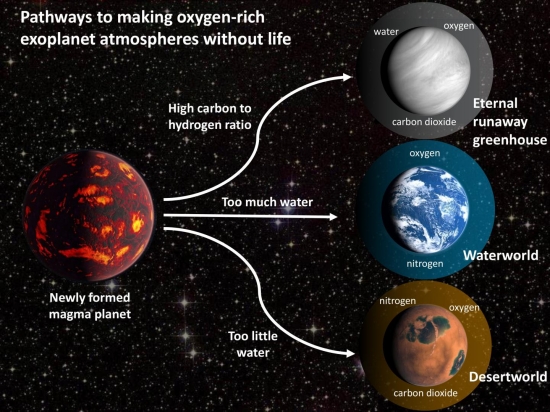
Image: By varying the initial inventory of volatile elements in a model of the geochemical evolution of rocky planets, researchers obtained a wide range of outcomes, including several scenarios in which a lifeless rocky planet around a sun-like star could evolve to have oxygen in its atmosphere. Credit: J. Krissansen-Totton).
The photodissociation referred to above occurs as ultraviolet light from the star breaks water molecules into hydrogen and oxygen in the upper atmosphere, with the lighter hydrogen escaping into space and the oxygen remaining as a potentially deceptive biosignature. But the paper also examines how oxygen can be removed from an atmosphere, through outgassing of carbon dioxide and hydrogen, which will react with oxygen. The weathering of rock also affects oxygen levels, all factors that need to be included in this model of geochemical evolution.
The model is given weight when we see that it can reproduce the evolution of the atmosphere both on the Earth and on Venus. Using it, then, we can explore possibilities. We can imagine a planet with more water than Earth, one whose deep oceans preclude weathering of rock that would remove oxygen. Conversely, on still molten young worlds with only a small inventory of water, the magma surface can solidify quickly, with water remaining in the atmosphere. Oxygen remains behind as hydrogen in the upper atmosphere escapes. Says Krissansen-Totton:
“The typical sequence is that the magma surface solidifies simultaneously with water condensing out into oceans on the surface. On Earth, once water condensed on the surface, escape rates were low. But if you retain a steam atmosphere after the molten surface has solidified, there’s a window of about a million years when oxygen can build up because there are high water concentrations in the upper atmosphere and no molten surface to consume the oxygen produced by hydrogen escape.”
Another scenario involves high amounts of carbon dioxide in relation to water, resulting in a runaway greenhouse. Here again, as the paper notes, we’ve got an oxygen problem:
The lack of liquid surface water precludes CO2?drawdown via silicate weathering… Reactions between supercritical water and silicates will be severely kinetically limited by sluggish solid state diffusion, and are therefore assumed to be negligible (Zolotov et al., 1997). Consequently, a dense CO2 atmosphere and supercritical surface temperature persist indefinitely… despite the planet residing in the habitable zone. Moreover, there is sufficient steam in the atmosphere to ensure diffusion?limited hydrogen escape provides an appreciable source flux of oxygen…
Its focus on the geochemical and thermal evolution of a planet in the habitable zone, emphasizing interactions between crust and atmosphere, make this a noteworthy addition to the ongoing attempt to understand biosignatures. We may well get a biosignature detection involving oxygen relatively quickly once we have the tools in place to delve into rocky worlds in the habitable zone. The effort to sort out its meaning will take considerable time.
I’l stand by a previous prediction: Initial euphoria will quickly wear off as we consider how deeply ambiguous any biosignature detection is going to be. I think we’ll be seeing plenty of interesting hints, but it will be many years before we can say with certainty that we have found life around another star.
The paper is Krissansen-Totton et al., “Oxygen False Positives on Habitable Zone Planets Around Sun?Like Stars,” Vol. 2, Issue 2 (June 2021). Full text.

Breakthrough Discuss Concluding Today
Breakthrough Discuss 2021 wraps up today, with presentations on mission concepts to Alpha Centauri, lightsail technologies and fusion propulsion. Of particular interest to me, in light of the magnitude of the problem as it affects the Breakthrough Starshot idea, is a session on the current state of deep space optical communications. This has been a lively and robust meeting — James Cameron’s appearance was particularly engaging, as was the Yuri’s Night panel discussion — and the public is invited to watch again today at https://www.youtube.com/breakthroughprize. Gathering my notes is going to be time-consuming, but many of these presentations will make their way into upcoming discussions on Centauri Dreams.
In light of the wide-ranging discussion on the Centauri stars and the challenge they present, it seems appropriate to introduce a quote I just ran into from Alan Lightman’s new book Probable Impossibilities (Pantheon, 2021). This is from a section talking about quantum cosmology, but it resonates with the energies that drive all human discovery:
In the 1940s, the American psychologist Abraham Maslow developed the concept of a hierarchy of human needs, starting with the most primitive and urgent, and ending with the most lofty and advanced for those fortunates who had satisfied the baser needs. At the bottom of the pyramid are physical needs for survival, like food and water. Next up is safety. Higher up is love and belonging, then self-esteem, and finally self-actualization. This highest of Maslow’s proposed needs is the desire to get the most out of ourselves, to be the best we can be. I would suggest adding one more category at the very top of the pyramid, even above self-actualization: imagination and exploration. The need to imagine new possibilities, the need to reach out beyond ourselves and understand the world around us. Wasn’t that need part of what propelled Marco Polo and Vasco da Gama and Einstein? Not only to help ourselves with physical survival or personal relationships or self-discovery, but to know and comprehend this strange cosmos we find ourselves in. The need to explore the really big questions asked by the quantum cosmologists. How did it all begin? Far beyond our own lives, far beyond our community or our nation or planet Earth or even our solar system. How did the universe begin? It is a luxury to be able to ask such questions. It is also a human necessity.

Breakthrough Discuss Ongoing
There is a public YouTube channel for watching the Breakthrough Discuss meetings, which began today and extend through tomorrow. Click here to go to sessions on “The Alpha Centauri System: A Beckoning Neighbor.” I’ll have thoughts on some of these presentations in coming weeks.

Dustfall: Earth’s Encounter with Micrometeorites
Interesting news out of CNRS (the French National Center for Scientific Research) renews our attention to the mechanisms for supplying the early Earth with water and carbonaceous molecules. We’ve looked at comets as possible water sources for a world forming well inside the snow line, and asteroids as well. What the CNRS work reminds us is that micrometeorites also play a role. In fact, according to the paper just out in Earth and Planetary Science Letters, 5,200 tons of extraterrestrial materials — dust particles from space — reach the ground yearly.
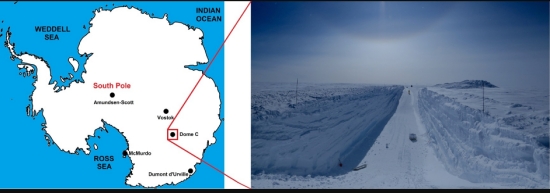
Image: From the paper’s Figure 1, although not the complete figure. The relevant part of the caption: Fig. 1. Left: Location of the CONCORDIA station (Dome C, Antarctica). Centre: View of a trench at Dome C. Credit: Rojas et al.
This conclusion comes from a study spanning almost twenty years, conducted by scientists in an international collaboration involving laboratories in France, the United States and the United Kingdom. CNRS researcher Jean Duprat has led six expeditions during this time span to the Franco-Italian Concordia station (Dome C), 1100 kilometers from the coast in the Antarctic territory Terre Adélie, which is claimed by France. France’s permanent outpost in Terre Adélie is Dumont d’Urville Station. The Dome C area is considered ideal for the study of micrometeorites because of the near absence of terrestrial dust and low rates of accumulation of snow.
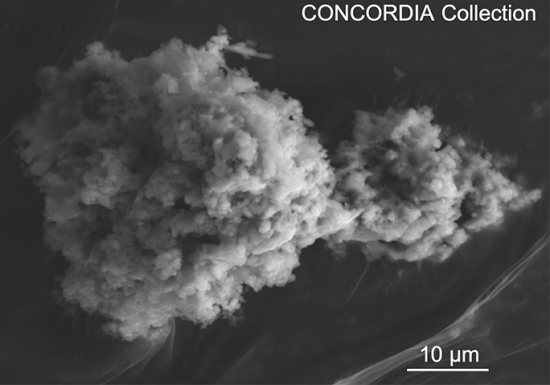
Image: Electron micrograph of a Concordia micrometeorite extracted from Antarctic snow at Dome. Credit: © Cécile Engrand/Jean Duprat.
The dust particles collected by these expeditions have ranged from 30 to 200 micrometers (µm) in size, and enough have been gathered to calculate the mass accreted to Earth per square meter per year, the aforementioned 5,200 tons. This would make micrometeorites the primary source of extraterrestrial matter on our planet — the flux from meteorites is measured as less than 10 tons per year.
The paper explains what happens as micrometeorites encounter the Earth’s atmosphere:
The degree of heating experienced by the particles during their atmospheric entry depends on various factors including the initial mass of the particles, their entry angle and velocity. The ablated metallic vapours oxidize and the resulting metal oxides, hydroxides and carbonates condense into nm-sized particles termed meteoric smoke (Plane et al., 2015). These particles are transported by the general atmospheric circulation until eventually deposited at the surface, where their flux can be evaluated by elemental or isotopic measurements (Gabrielli et al. (2004).
The size distribution of extraterrestrial particles before entry into the atmosphere was studied by measuring the craters that high velocity sub-millimetre grain collisions produced on the Long Duration Exposure Facility satellite (LDEF) panel. This was an interesting mission. The LDEF spent over five years orbiting the Earth to measure the effects of micrometeoroids, space debris, radiation particles, atomic oxygen, and solar radiation on spacecraft materials, components, and systems before being retrieved in 1990 by the Space Shuttle STS-32 mission.

Image: Collecting micrometeorites in the central Antarctic regions, at Dome C in 2002. Snow sampling. Credit: © Jean Duprat/ Cécile Engrand/ CNRS Photothèque.
The paper is Rojas et al., “The micrometeorite flux at Dome C (Antarctica), monitoring the accretion of extraterrestrial dust on Earth,” Earth and Planetary Science Letters Volume 560 (15 April 2021) 116794 (full text).

How Planetesimals Are Born
What governs the size of a newly forming star as it emerges from the molecular cloud around it? The answer depends upon the ability of gravity to overcome internal pressure within the cloud, and that in turn depends upon exceeding what is known as the Jeans Mass, whose value will vary with the density of the gas and its temperature. Exceed the Jeans mass and runaway contraction begins, forming a star whose own processes of fusion will arrest the contraction.
At the Max Planck Institute for Astronomy (Heidelberg), Hubert Klahr and colleagues have been working on a different kind of contraction, the processes within the protoplanetary disk around such young stars. Along with postdoc Andreas Schreiber, Klahr has come up with a type of Jeans Mass that can be applied to the formation of planetesimals. While stars in formation must overcome the pressure of their gas cloud, planetesimals work against turbulence within the gas and dust of a disk — a critical mass is needed for the clump to overcome turbulent diffusion. The new paper on this work extends the findings reported in a 2020 paper by the same authors.
The problem this work is trying to solve has to do with the size distribution of asteroids; specifically, why do primordial asteroids — planetesimals that have survived intact since the formation of the Solar System, without the collisions that have fragmented so many such objects — tend to be found with a diameter in the range of 100 kilometers? To answer the question, the researchers look at the behavior of pebbles in the disk, small clumps in the range of a few millimeters to a few centimeters in size. Here the plot thickens.
Pebbles tend to drift inward toward the star, meaning that if these pebbles accrete slowly, they would fall into the star before reaching the needed size. Klahr and Schreiber argue that this drift can be overcome thanks to turbulence within the gas of the protoplanetary disk, creating traps where the pebbles can accumulate enough mass for them to become bound together by gravity. Turbulence is a local effect, to be sure, but it can also vary as the disk changes with increased distance from the star. A fast enough drop in gas pressure with distance can create a streaming instability within the disk, so that pebbles move chaotically and churn the gas around them.

Image: The solar primordial nebula of gas and dust surrounds the sun in the form of a flat disk. In it are vortices in which the small pebbles accumulate. These pebbles can grow up to asteroid size by gravitational collapse, if this is not hindered by turbulent diffusion. Hubert Klahr, Andreas Schreiber, MPIA / MPIA Graphics Department, Judith Neidel.
So on the one hand, turbulence helps create the pebble clusters that can aggregate into larger objects, but to grow larger still, such clouds need to reach a certain mass or they will be dispersed by these instabilities. Klahr and Schreiber’s calculations of the necessary mass show that objects would need to reach 100 kilometers in size to overcome the turbulence pressure for most regions within our own Solar System, matching observation. Thus we have a limiting mass for planetesimal formation.
All of this grows out of simulations and the comparison of their results with telescopic observations of protoplanetary disks around young stars. In the numerical models the authors used, planetesimals grow quickly from the projected pebble traps. Low mass pebble clouds below this turbulence-based Jeans Mass are less likely to grow through accretion, while larger clouds would collapse as they exceeded the critical mass.
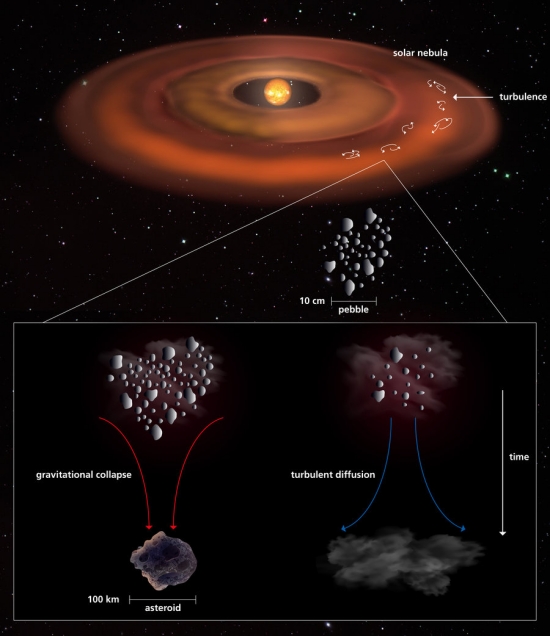
Image: In this schematic the sequence of planetesimal formation starts with particles growing to pebble size. These pebbles then accumulate at the midplane and drift toward the star to get temporarily trapped in a zonal flow or vortex. Here the density of pebbles in the midplane is eventually sufficient to trigger the streaming instability. This instability concentrates and diffuses pebbles likewise, leading to clumps that reach the Hill density at which tidal forces from the star can no longer shear the clumps away. If now also the turbulent diffusion is weak enough to let the pebble cloud collapse, then planetesimal formation will occur. Hubert Klahr, Andreas Schreiber, MPIA / MPIA Graphics Department, Judith Neidel.
Planetesimal size does vary at larger distances, such that objects forming in the outer regions of the disk cluster around 10 kilometers at 100 AU. The authors suggest that the characteristic size of Kuiper Belt Objects will be found to decrease with increasing distance from the Sun, something that future missions into that region can explore. The 100 kilometer diameter seems to hold out to about 60 AU, beyond which smaller objects form from a depleted disk.
New Horizons comes to mind as the only spacecraft to study such an object, the intriguing 486958 Arrokoth, which at 45 AU is the most distant primordial object visited by a space probe. Future missions will give us more information about the size distribution of Kuiper Belt Objects. We can also think about the Lucy mission, whose solar panels we looked at yesterday. The target asteroids orbit at the Jupiter Lagrange points 4 and 5, one group ahead of the planet in its orbit, one group behind. Lucy is to visit six Trojans, objects which evidently migrated from different regions in the Solar System and may include a population of primordial planetesimals.
Klahr and Schreiber have come up with a model that can make predictions about how planetesimals form within the protoplanetary disk and their likely sizes within the disk. Whether these predictions are born out by subsequent observation will help us choose between this new Jeans Mass model for planetesimals and other formation processes, including the possibility that ice is the mechanism allowing pebbles to stick together, or whether aggregates of silicate flakes are the answer. Klahr is not convinced that either of these models can withstand scrutiny:
“Even if collisions were to lead to growth up to 100 km without eventually switching to a gravitational collapse, this method would predict too large a number of asteroids smaller than 100 km. It would also fail to describe the high frequency of binary objects in the Edgeworth-Kuiper belt. Both properties of our Solar System are easily reconcilable with the gravitational pebble cloud collapse.”
The effects of turbulence in other stellar systems will likewise rely upon the concentration of mass within the disk, with the ability for larger planetesimals to form decreasing as the gas within the disk is depleted, either by planet formation or by absorption by the host star. If Klahr and Schreiber’s model of planetesimal formation as a function of gas pressure is applicable to what we are seeing in protoplanetary disks around other stars, then it should prove useful for scientists building population synthesis models to incorporate planetesimals into the mix.
The previously published paper is Klahr & Schreiber, “Turbulence Sets the Length Scale for Planetesimal Formation: Local 2D Simulations of Streaming Instability and Planetesimal Formation,” Astrophysical Journal Volume 901, Issue 1, id.54, (September, 2020). Abstract. The upcoming paper is “Testing the Jeans, Toomre and Bonnor-Ebert concepts for planetesimal formation: 3D streaming instability simulations of diffusion regulated formation of planetesimals,” in process at the Astrophysical Journal (preprint).

Lucy: Solar Panel Deployment Tests a Success
It’s easy to forget how large our space probes have been. A replica of the Galileo probe during at the Jet Propulsion Laboratory can startle at first glance. The spacecraft was 5.3 meters high (17 feet), but an extended magnetometer boom telescoped out to 11 meters (36 feet). Not exactly the starship Enterprise, of course, but striking when you’re standing there looking up at the probe and pondering what it took to deliver this entire package to Jupiter orbit in the 1990s.
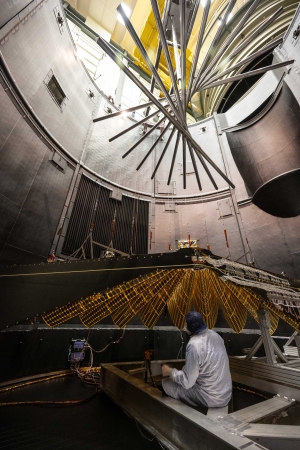
The same feeling settles in this morning with news out of Lockheed Martin Space, where in both December 2020 and February of 2021 final deployment tests were conducted on the solar arrays that will fly aboard the Lucy mission. Scheduled for launch this fall (the launch window opens on October 16), Lucy is to make a 12-year reconnaissance of the Trojan asteroids of Jupiter. Given that energy from the Sun is inversely proportional to the square of the distance, Lucy in Jupiter space will receive only 1/27th of the energy available at Earth orbit
Image: Seen here partially unfurled, the Lucy spacecraft’s massive solar arrays completed their first deployment tests in January 2021 inside the thermal vacuum chamber at Lockheed Martin Space in Denver, Colorado. To ensure no extra strain was placed on the solar arrays during testing in Earth’s gravity environment, the team designed a special mesh wire harness to support the arrays during deployment. Credit: Lockheed Martin
“The success of Lucy’s final solar array deployment test marked the end of a long road of development. With dedication and excellent attention to detail, the team overcame every obstacle to ready these solar panels.”
Those are the words of Matt Cox, Lockheed Martin’s Lucy program manager, in Littleton, Colorado, who added:
“Lucy will travel farther from the Sun than any previous solar-powered Discovery-class mission, and one reason we can do that is the technology in these solar arrays.”
Lucy will actually move beyond Jupiter’s orbit in its study of the Trojans, up to 853 million kilometers out, so we need big panels. With the panels attached and fully extended, they could cover a five-story building. They’ll need to supply about 500 watts to the spacecraft and its instruments. Manufactured by Northrop Grumman, each solar panel when folded is no more than 4 centimeters thick, but when expanded, will have a diameter of almost 7.3 meters.
[But see Alex Tolley’s comment below. I believe the solar panel thickness is actually 10 cm]
The good news is that with the help of weight offloading devices for needed support under gravity, the deployment tests, conducted in a thermal vacuum chamber at Lockheed Martin Space in Denver, went flawlessly. Hal Levison (Southwest Research Institute) points to the critical nature of the process:
“At about one hour after the spacecraft launches, the solar panels will need to deploy flawlessly in order to assure that we have enough energy to power the spacecraft throughout the mission. These 20 minutes will determine if the rest of the 12 year mission will be a success. Mars landers have their seven minutes of terror, we have this.”
Which takes me back momentarily to Galileo, where the ‘seven minutes of terror’ involved about 165 seconds, the time it was believed it would take the spacecraft’s actuators to deploy its high-gain antenna. The failure to deploy properly ultimately forced controllers to use a low-gain antenna to return data, a workaround that produced great science but at a much reduced rate. We know what happened here, which involved events during the 4.5 years Galileo spent in storage following the explosion of the Challenger shuttle, and we can hope that the thorough deployment tests at Lockheed Martin Space will ensure a successful deployment for Lucy.
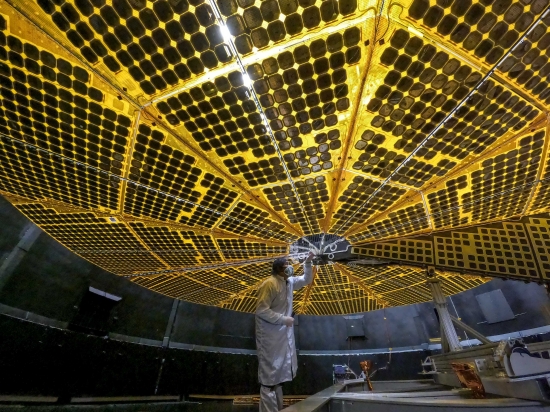
Image: At 24 feet (7.3 meters) across each, Lucy’s two solar panels underwent initial deployment tests in January 2021. In this photo, a technician at Lockheed Martin Space in Denver, Colorado, inspects one of Lucy’s arrays during its first deployment. These massive solar arrays will power the Lucy spacecraft throughout its entire 4-billion-mile, 12-year journey as it heads out to explore Jupiter’s elusive Trojan asteroids. Credit: Lockheed Martin.

